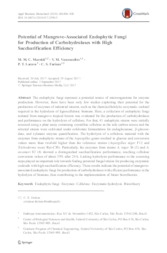Potential of mangrove-associated endophytic fungi for production of carbohydrolases with high saccharification efficiency.
Potential of mangrove-associated endophytic fungi for production of carbohydrolases with high saccharification efficiency.
Autoria: MAROLDI, M. M. C.; VASCONCELLOS, V. M.; LACAVA, P. T.; FARINAS, C. S.
Resumo: The endophytic fungi represent a potential source of microorganisms for enzyme production. However, there have been only few studies exploiting their potential for the production of enzymes of industrial interest, such as the (hemi)cellulolytic enzymatic cocktail required in the hydrolysis of lignocellulosic biomass. Here, a collection of endophytic fungi isolated from mangrove tropical forests was evaluated for the production of carbohydrolases and performance on the hydrolysis of cellulose. For that, 41 endophytic strains were initially screened using a plate assay containing crystalline cellulose as the sole carbon source and the selected strains were cultivated under solid-state fermentation for endoglucanase, β-glucosidase, and xylanase enzyme quantification. The hydrolysis of a cellulosic material with the enzymes from endophytic strains of the Aspergillus genus resulted in glucose and conversion values more than twofold higher than the reference strains (Aspergillus niger F12 and Trichoderma reesei Rut-C30). Particularly, the enzymes from strains A. niger 56 (3) and A. awamori 82 (4) showed a distinguished saccharification performance, reaching cellulose conversion values of about 35% after 24 h. Linking hydrolysis performance to the screening steps played an important role towards finding potential fungal strains for producing enzymatic cocktails with high saccharification efficiency. These results indicate the potential of mangroveassociated endophytic fungi for production of carbohydrolases with efficient performance in the hydrolysis of biomass, thus contributing to the implementation of future biorefineries.
Ano de publicação: 2018
Tipo de publicação: Artigo de periódico
Unidade: Embrapa Instrumentação
Palavras-chave: Biorefinery, Endophytic fungi
Observações
1 - Por padrão são exibidas publicações dos últimos 20 anos. Para encontrar publicações mais antigas, configure o filtro ano de publicação, colocando o ano a partir do qual você deseja encontrar publicações. O filtro está na coluna da esquerda na busca acima.
2 - Para ler algumas publicações da Embrapa (apenas as que estão em formato ePub), é necessário ter, no celular ou computador, um desses softwares gratuitos. Sistemas Android: Google Play Livros; IOS: iBooks; Windows e Linux: software Calibre.
Acesse outras publicações
Acesse a Base de Dados da Pesquisa Agropecuária (BDPA) para consultar o acervo completo das bibliotecas da Embrapa.

